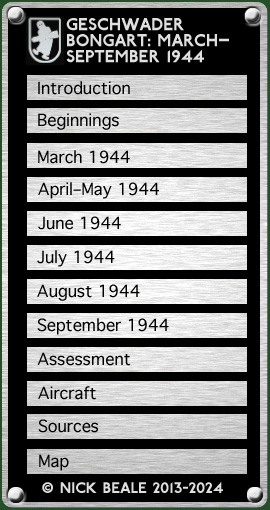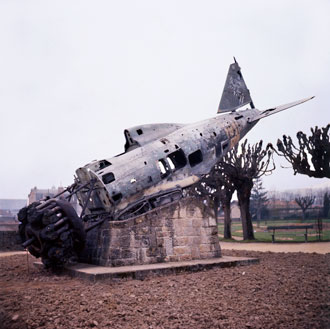|
If innocent people get hit, that is regrettable but it is exclusively the fault of the terrorists. Generalfeldmarschall Hugo Sperrle (3 February 1944) Geschwader Bongart’s rapid transformation into a combat unit was at once an indication of the Luftwaffe’s flexibility and its weakness. The increasing threat to German communications, life and property posed by French insurgency was countered by the redeployment of assets already to hand, but Luftflotte 3 was unable to constitute a specially trained and equipped formation. It was not even able to rationalise the new unit’s aircraft inventory to minimise maintenance and supply problems. Geschwader Bongart operated a ragbag of types and sub-types, even within individual Staffeln. None of these aircraft was new — one Bf 110 had been built in April 1940 — and probably the most modern machine on strength was a Bf 109 G-5 handed down from JG 1. The Geschwader met neither aerial opposition nor, apparently, any anti-aircraft defence more powerful than infantry machine guns and seems to have lost very few aeroplanes on operations. Throughout the summer, Resistance activity in Central and Southern France increased while the German presence was weakened by the deployment of divisions to Normandy. Neither the ground forces nor the Luftwaffe could maintain continuous cover of every insecure area. From the German perspective, it was probably most effectively employed in the context of 1944’s successive punitive expeditions by ground forces against Maquis-held areas. As seems inevitable in counter-insurgency warfare, large numbers of non-combatants were killed because (then as now) they found themselves in the way of armed force or fell victim to reprisals or intimidatory violence. Judging by the towns and villages whose casualties are given above, with the possible exception of the Vercors operation, Geschwader Bongart probably killed far more civilians than Resistance fighters. At times German intelligence was either faulty or none too particular and a “partisan village” — Séderon for example — could be occupied almost entirely by non-combatants. It is difficult to escape the impression that the Germans retrospectively classified almost everyone they killed during these operations as a terrorist. There is no doubt that Bongart was used to support ground operations during which atrocities were committed either in the treatment of combatants or in “reprisals” against such civilians as happened to be in the vicinity. The Geschwader reported on its operations not only to Luftflotte 3 but also to the number two in the SS police and security apparatus in France. It seems probable that these agencies were identifying targets for the Geschwader and a number of them were divorced from any current ground fighting. Such attacks appear to have been intended as punishment or intimidation (“deterrence” in modern terms) — letting the populace know that they were being watched and that resistance activity came at a cost. Whether the aircrew were ever briefed in such terms is unknown but those directing operations had no need for honesty when euphemisms such as “important terrorist base” would have served equally well. In writing this article, I’ve found that internet searches on place names cropping up in wartime sources often produce more detail or leads to other air attacks. Towns, organisations and individuals across France have worked to document the actions fought by local Resistance groups and to commemorate the lives lost during the occupation, deportations and liberation. The many 70th anniversaries occurring in 2014 have brought a spate of new pages as commemorations are held and exhibtions mounted. In Lyon, the Cercle Aéronautique Louis Mouillard (C.A.L.M) has produced “Les Bombardements de Représailles Allemandes sur la Région Rhône-Alpes, Été 1944” (German reprisal bombings in the Rhône-Alpes Region, Summer 1944). This carries two copyright dates, October 2013 and June 2014; for most of the incidents it does not cite individual sources. Sources for Luftwaffe units are given as “ULTRA decrypyts; Geschwader Bongart by Beale and deZeng; article by P. [sic] Baudru in Jet & Prop; Sonderkommando Bongart by Jean-Louis Roba”, the most recent of which appeared 15 years ago. The C.A.L.M. document gives valuable leads which can be cross-checked but it does mention some bombings or strafings which I haven’t been able to corroborate so far:
I learned a lot more about the March 1944 Glières operation from http://beaucoudray.free.fr. This site commemorates a Maquis operating around the St. Lô area of Normandy, its pages have a vivid orange background and its navigation system is unfathomable — I found the extensive Glières pages via a search engine, they don’t seem to be accessible from within the site itself. Especially useful were the details (drawn from Bundesarchiv files) of debates among German commanders about the use of aircraft in the operation.
Something else I’ve learned as this article has evolved is not to take too literally the contemporary accounts of the numbers and types of aircraft involved, the quantity and calibre of their bombs or where their bases were. I’ve recently finished reading Dr. Peter Lieb’s »Konventioneller Krieg oder NS-Weltanschauungskrieg, Kriegführung und Partisanenbekämpfung in Frankreich 1943/44« (“Conventional War or War of National Socialist Ideology? Warfare and Combatting Partisans in France 1943/44”). Originally a doctoral thesis, this is not a day-by-day campaign history; Lieb’s concern is rather to explore why different German units acted as they did, especially toward civilians, prisoners of war and irregular forces. He has explored a vast range of archival sources and offers the clearest explanation I have seen of the German military and Police/Security resources committed to the fight against French insurgency, along with a picture of the major anti-partisan actions, the units involved and lives lost. His appendices tabulate the German command structure in France and known massacres of civilians and prisoners. However, Dr. Lieb has nothing to say about the role of German airpower in anti-Resistance operations beyond a footnote mentioning the attack on Tarbes, two instances of leaflet-dropping and the air-landing operation on the Vercors Plateau. This is all the more surprising given that aircraft were undoubtedly responsible for some of the human and material desrtuction, not least in the Vercors villages, which he has so assiduously investigated. Nevertheless, »Konventioneller Krieg …« gives valuable context for the air operations I have described above, especially the Germans’ recognition that their ground forces were too few to exercise consistent control over a territory and population as large as those of France. This led them periodically to stage punitive expeditions into areas “infested” by the Maquis, both to engage the guerillas and to deter (»abschrecken«) the local population from helping them. It is not difficult to see how shows of aerial force could reinforce these efforts by thinly-spread ground troops. continued on next page …
|
|||||||||||||||||


